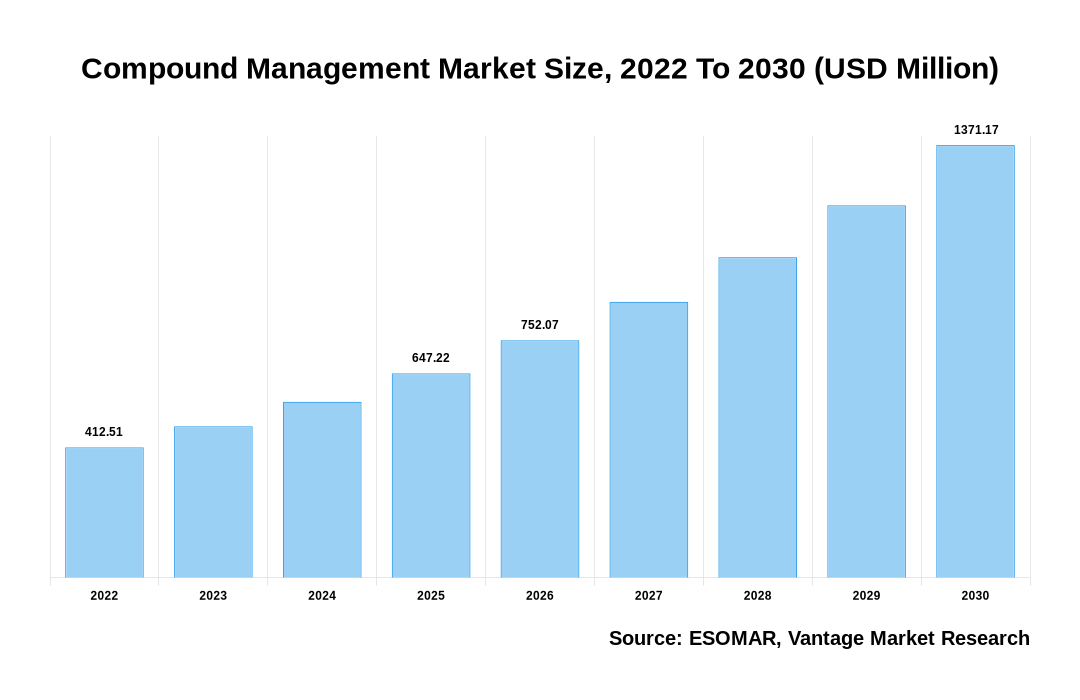Global Compound Management Market
As stated in our extensive report; the Global Compound Management Market accounted for USD 355.5 Million in the year 2021.
Some important drivers propelling the market are rising drug discovery efforts, expansion in the pharmaceutical and biotechnology sectors, and rising demand for outsourcing these services. There has been an obvious increase in the medication pipeline in recent years.

Click To Get a Free Sample On the Research Study
In 2020, there were 17,737 pharmaceuticals in the R&D pipeline, and in 2022, there were 20,109 drugs in the pipeline, according to Pharma R&D annual review 2022. The market is anticipated to benefit from the expanding medicinal pipeline. The majority of COVID-19 medications and vaccines were in development during the pandemic. However, according to the Pharma R & D annual assessment for 2022, the two main pharmaceuticals in development at the time were biotechnology and anticancer medications. Due to the increased demand for biotechnology and anticancer medications worldwide, the drug pipeline for these substances is anticipated to improve in the upcoming years. In the post-pandemic period, this is anticipated to enhance demand for Compound Management of biotechnology and anticancer medications.
Key factors influencing Compound Management Market Growth
The growth of the global Compound Management market can be attributable to the following:
- Growing pharmaceutical R&D and new drug development projects, rising pharmaceutical sample collection, storage, and transportation activities, rising demand for Compound Management outsourcing services, and growing research collaborations between top pharmaceutical companies are the main factors expected to drive the global Compound Management market revenue over the forecast period.
- In addition, the increasing need for entirely automated Compound Management systems is another prominent element that is projected to significantly contribute to the growth of the global market’s revenue.
- It is anticipated that a lack of skilled labor and high investment prices will impede market expansion. Due to investments in hardware and software, including installing modern automated liquid compound storage systems coupled with a sizeable inventory database, a compound/sample management facility requires a sizable amount of capital. For instance, the price of a largely automated storage system is between US$1 million and US$10 million.
- The main drivers of the developing Compound Management markets include low labor and raw material prices, expanding life science research, government backing, technological integration, and innovations.
- Collaboration between the Department of Biotechnology (DBT) and government-funded institutions like the National Biotechnology Board has turned India into a biotechnology research hub (NBTB) hub.
- Compound destruction, a rise in downtime, and a delay in research start might result from ineffective and unreliable Compound Management. On the other hand, imprecise and bad Compound Management can greatly influence research and development.
- Moreover, Compound Management can significantly impact drug development workflows, causing unneeded delays due to segmented and transitory processes.
- The growing need for fully automated Compound Management systems is another prominent factor that is projected to significantly contribute to the growth of the global market’s revenue.
- A number of procedures are supported by fully automated Compound Management systems, including compound weighing and dissolving, assay plate preparation, library maintenance, and others.
North America Region to Lead the Market
North America Compound Management market is getting more significant with maximum market share during the forecast period. This is because the region is home to numerous pharmaceutical and biotechnology companies engaged in the drug discovery. Consequently, there is a rising need for services in this area. A further factor driving this sector’s growth is the increase in disease-related morbidity and death, which has created more medication candidates. Public entities’ positive drug discovery and research endeavors foster regional market expansion.
Over the projected period, Asia Pacific is predicted to increase at the fastest rate. Ongoing drug discovery research, public-private partnerships, and government initiatives will likely fuel regional market expansion. Japan made a major contribution to the market expansion because of favorable government assistance. Research on cancer and tissue diagnostics is supported by the updated Pharmaceutical Affairs Law in Japan, which is anticipated to push the industry in this nation soon. Additionally, the low cost of outsourcing Compound Management services in Asia Pacific nations and the region’s high prevalence of infectious and chronic diseases fuel demand for research, supporting the expansion of the regional industry.
Conclusion
Rising drug discovery efforts, expansion in the pharmaceutical and biotechnology sectors, and rising demand for outsourcing these services are positively influencing the overall Compound Management market.
Some of the key players in the Global Compound Management Market include- Brooks Life Sciences (US), Titian Software Limited (UK), Beckman Coulter Inc (US), Hamilton Company (US) , Evotec (Germany) and others.
![[Market Research Reports] – Research Google News Blog | VMR.Biz](https://www.vmr.biz/wp-content/uploads/2022/12/logo-removebg-preview.png)











